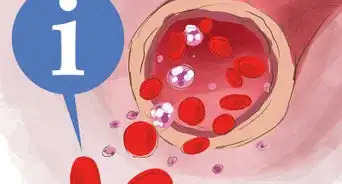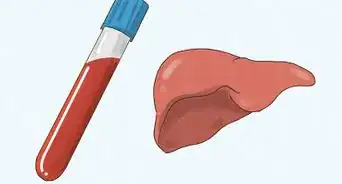This article was co-authored by Michael Lewis, MD, MPH, MBA, FACPM, FACN and by wikiHow staff writer, Amy Bobinger. Michael D. Lewis, MD, MPH, MBA, FACPM, FACN, is an expert on nutritional interventions for brain health, particularly the prevention and rehabilitation of brain injury. In 2012 upon retiring as a Colonel after 31 years in the U.S. Army, he founded the nonprofit Brain Health Education and Research Institute. He is in private practice in Potomac, Maryland, and is the author of "When Brains Collide: What every athlete and parent should know about the prevention and treatment of concussions and head injuries." He is a graduate of the U.S. Military Academy at West Point and Tulane University School of Medicine. He completed post-graduate training at Walter Reed Army Medical Center, Johns Hopkins University, and Walter Reed Army Institute of Research. Dr. Lewis is board certified and a Fellow of the American College of Preventive Medicine and American College of Nutrition.
There are 24 references cited in this article, which can be found at the bottom of the page.
wikiHow marks an article as reader-approved once it receives enough positive feedback. This article received 31 testimonials and 100% of readers who voted found it helpful, earning it our reader-approved status.
This article has been viewed 774,418 times.
Your blood carries oxygen and important nutrients throughout your body, so it's really important to have a steady, healthy level of blood flow to your brain. In fact, decreased blood flow to your brain is associated with a number of health concerns, including an increased risk of dementia, depression, and stroke. Fortunately, it's actually possible to improve your circulation and increase blood flow for a healthier brain. This article will walk you through a variety of simple lifestyle changes that can help.
Steps
Expert Q&A
-
QuestionI am experiencing numbness in my head during night time. I was operated on for a brain tumor 4 years ago. Is this related to the surgery?
 Chris M. Matsko, MDDr. Chris M. Matsko is a retired physician based in Pittsburgh, Pennsylvania. With over 25 years of medical research experience, Dr. Matsko was awarded the Pittsburgh Cornell University Leadership Award for Excellence. He holds a BS in Nutritional Science from Cornell University and an MD from the Temple University School of Medicine in 2007. Dr. Matsko earned a Research Writing Certification from the American Medical Writers Association (AMWA) in 2016 and a Medical Writing & Editing Certification from the University of Chicago in 2017.
Chris M. Matsko, MDDr. Chris M. Matsko is a retired physician based in Pittsburgh, Pennsylvania. With over 25 years of medical research experience, Dr. Matsko was awarded the Pittsburgh Cornell University Leadership Award for Excellence. He holds a BS in Nutritional Science from Cornell University and an MD from the Temple University School of Medicine in 2007. Dr. Matsko earned a Research Writing Certification from the American Medical Writers Association (AMWA) in 2016 and a Medical Writing & Editing Certification from the University of Chicago in 2017.
Family Medicine Physician Superficial numbness in your head may be a residual side effect of the surgery. I would check with your surgeon if this continues to be of concern.
Superficial numbness in your head may be a residual side effect of the surgery. I would check with your surgeon if this continues to be of concern. -
QuestionI'm taking estrogen for hot flashes and I've been experiencing brain fog. I feel very tired after simply having a conversation with someone. What is going on?
 Chris M. Matsko, MDDr. Chris M. Matsko is a retired physician based in Pittsburgh, Pennsylvania. With over 25 years of medical research experience, Dr. Matsko was awarded the Pittsburgh Cornell University Leadership Award for Excellence. He holds a BS in Nutritional Science from Cornell University and an MD from the Temple University School of Medicine in 2007. Dr. Matsko earned a Research Writing Certification from the American Medical Writers Association (AMWA) in 2016 and a Medical Writing & Editing Certification from the University of Chicago in 2017.
Chris M. Matsko, MDDr. Chris M. Matsko is a retired physician based in Pittsburgh, Pennsylvania. With over 25 years of medical research experience, Dr. Matsko was awarded the Pittsburgh Cornell University Leadership Award for Excellence. He holds a BS in Nutritional Science from Cornell University and an MD from the Temple University School of Medicine in 2007. Dr. Matsko earned a Research Writing Certification from the American Medical Writers Association (AMWA) in 2016 and a Medical Writing & Editing Certification from the University of Chicago in 2017.
Family Medicine Physician Perhaps you are feeling a little depressed with this change in life. I would seek out the attention of a trained medical professional so that you can be properly evaluated for menopause.
Perhaps you are feeling a little depressed with this change in life. I would seek out the attention of a trained medical professional so that you can be properly evaluated for menopause. -
QuestionWhat kind of exercise will help boost my brain's blood flow?
 Michael Lewis, MD, MPH, MBA, FACPM, FACNMichael D. Lewis, MD, MPH, MBA, FACPM, FACN, is an expert on nutritional interventions for brain health, particularly the prevention and rehabilitation of brain injury. In 2012 upon retiring as a Colonel after 31 years in the U.S. Army, he founded the nonprofit Brain Health Education and Research Institute. He is in private practice in Potomac, Maryland, and is the author of "When Brains Collide: What every athlete and parent should know about the prevention and treatment of concussions and head injuries." He is a graduate of the U.S. Military Academy at West Point and Tulane University School of Medicine. He completed post-graduate training at Walter Reed Army Medical Center, Johns Hopkins University, and Walter Reed Army Institute of Research. Dr. Lewis is board certified and a Fellow of the American College of Preventive Medicine and American College of Nutrition.
Michael Lewis, MD, MPH, MBA, FACPM, FACNMichael D. Lewis, MD, MPH, MBA, FACPM, FACN, is an expert on nutritional interventions for brain health, particularly the prevention and rehabilitation of brain injury. In 2012 upon retiring as a Colonel after 31 years in the U.S. Army, he founded the nonprofit Brain Health Education and Research Institute. He is in private practice in Potomac, Maryland, and is the author of "When Brains Collide: What every athlete and parent should know about the prevention and treatment of concussions and head injuries." He is a graduate of the U.S. Military Academy at West Point and Tulane University School of Medicine. He completed post-graduate training at Walter Reed Army Medical Center, Johns Hopkins University, and Walter Reed Army Institute of Research. Dr. Lewis is board certified and a Fellow of the American College of Preventive Medicine and American College of Nutrition.
Board Certified Brain Health Physician It's really just about getting your heart rate up. You can do that by lifting weights, walking quickly, or doing calisthenics. You don't necessarily have to run on a treadmill at a hard pace for half an hour.
It's really just about getting your heart rate up. You can do that by lifting weights, walking quickly, or doing calisthenics. You don't necessarily have to run on a treadmill at a hard pace for half an hour.
References
- ↑ https://www.health.harvard.edu/blog/cocoa-sweet-treat-brain-201502057676
- ↑ https://my.clevelandclinic.org/health/articles/16774-heart-healthy-benefits-of-chocolate
- ↑ https://pubmed.ncbi.nlm.nih.gov/9134116/
- ↑ https://www.ncbi.nlm.nih.gov/pmc/articles/PMC5861951/
- ↑ https://www.nrronline.org/article.asp?issn=1673-5374;year=2014;volume=9;issue=16;spage=1557;epage=1566;aulast=Subash
- ↑ https://www.sciencedaily.com/releases/2017/04/170412181341.htm
- ↑ https://article.sciencepublishinggroup.com/html/10.11648.j.ijecs.20160101.11.html
- ↑ https://news.stanford.edu/news/2012/september/austen-reading-fmri-090712.html
- ↑ https://www.psu.edu/news/research/story/increased-blood-flow-during-sleep-tied-critical-brain-function/
- ↑ https://www.cdc.gov/sleep/about_sleep/how_much_sleep.html
- ↑ Michael Lewis, MD, MPH, MBA, FACPM, FACN. Board Certified Brain Health Physician. Expert Interview. 18 February 2021.
- ↑ https://pubmed.ncbi.nlm.nih.gov/17722948/
- ↑ http://www.mayoclinic.org/healthy-lifestyle/fitness/in-depth/stretching/art-20047931?pg=2
- ↑ https://www.liebertpub.com/doi/10.1089/acm.2019.0060
- ↑ https://pubmed.ncbi.nlm.nih.gov/14620252/
- ↑ https://www.sciencedirect.com/topics/medicine-and-dentistry/prefrontal-cortex
- ↑ http://www.mayoclinic.org/tests-procedures/meditation/in-depth/meditation/art-20045858?pg=2
- ↑ https://www.hindawi.com/journals/srt/2011/692595/
- ↑ https://www.ncbi.nlm.nih.gov/pmc/articles/PMC3135375/
- ↑ https://www.liebertpub.com/doi/10.1089/acm.2010.0232
- ↑ https://journals.lww.com/nuclearmedicinecomm/pages/articleviewer.aspx?year=1996&issue=06000&article=00004&type=abstract
- ↑ https://www.mayoclinic.org/diseases-conditions/seasonal-affective-disorder/in-depth/seasonal-affective-disorder-treatment/art-20048298
- ↑ http://www.nhs.uk/smokefree/why-quit/smoking-health-problems
- ↑ http://health.clevelandclinic.org/2014/09/e-cigarettes-tobacco-free-but-your-heart-may-still-be-at-risk/
About This Article
To increase blood flow to the brain, start by taking short walks throughout the day to help your overall circulation. You can also try simple stretches every day, like touching your knees, shins, or toes from a standing or sitting position. Additionally, practice breathing deeply through your nose and engaging your abdominal area when you breathe to maximize your oxygen intake. You can also eat chocolate, avocados, nuts, and blueberries to help maintain a healthy brain. For more tips from our Medical co-author, like how to do yoga to increase blood flow, read on!


























-Step-14-Version-2.webp)


















































Medical Disclaimer
The content of this article is not intended to be a substitute for professional medical advice, examination, diagnosis, or treatment. You should always contact your doctor or other qualified healthcare professional before starting, changing, or stopping any kind of health treatment.
Read More...